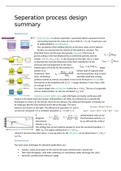Samenvatting
Summary Separation Process Design, wur, BPE20806
- Instelling
- Wageningen University (WUR)
A summary of the course Separation Process Design, given in the second year of the bachelor Biotechnology. This summary includes all content needed for the exam.
[Meer zien]




